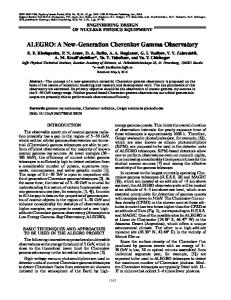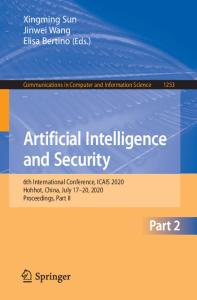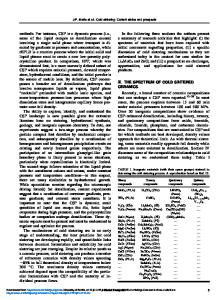TAIGA Gamma Observatory: Status and Prospects
- PDF / 1,479,418 Bytes
- 11 Pages / 612 x 792 pts (letter) Page_size
- 58 Downloads / 551 Views
EMENTARY PARTICLES AND FIELDS Experiment
TAIGA Gamma Observatory: Status and Prospects L. A. Kuzmichev1), 2) , I. I. Astapov3) , P. A. Bezyazeekov2) , V. Boreyko4), A. N. Borodin4) , N. M. Budnev2) , R. Wischnewski5) , A. Y. Garmash6), 7) , A. R. Gafarov2) , N. V. Gorbunov4) , V. M. Grebenyuk4) , O. A. Gress2) , T. I. Gress2) , A. A. Grinyuk4) , O. G. Grishin2), A. N. Dyachok2), A. V. Zagorodnikov2) , V. L. Zurbanov2), A. L. Ivanova2), Y. A. Kazarina2), N. N. Kalmykov1), N. I. Karpov1), V. V. Kindin3) , P. S. Kirilenko6) , S. N. Kiryuhin2), V. A. Kozhin1) , R. P. Kokoulin3), K. G. Kompaniets3) , E. E. Korosteleva1) , E. A. Kravchenko6), 7) , M. Kunnas8) , A. Chiavassa9), A. A. Lagutin10) , V. V. Lenok2) , B. K. Lubsandorzhiev11), N. B. Lubsandorzhiev1), R. R. Mirgazov2) , R. Mirzoyan12) , R. D. Monkhoev2), R. Nachtigall7) , E. A. Osipova1), M. I. Panasyuk1), L. V. Pankov2) , A. L. Pakhorukov2), A. A. Petrukhin3) , V. A. Poleschuk2), M. Popesku13) , E. G. Popova1), A. Porelli5) , E. B. Postnikov1)* , V. V. Prosin1) , V. S. Ptuskin14) , A. A. Pushnin2) , R. I. Raikin10), G. I. Rubtsov11), Ya. I. Sagan4) , V. S. Samoliga2), L. G. Sveshnikova1), Yu. A. Semeney2) , A. Y. Sidorenkov11), А. А. Silaev1), A. A. Silaev Jr.1) , A. V. Skurikhin1), M. Slunecka4), A. V. Sokolov6), 7) , V. P. Sulakov1), V. A. Tabolenko2) , B. A. Tarashansky2), L. G. Tkachev4), A. V. Tkachenko4), M. Tluczykont8), O. L. Fedorov2), A. D. Horns8) , C. Spiering5) , A. Sh. M. Elshoukrofy1), 15) , and I. I. Yashin3) Received January 26, 2018
Abstract—Over the past few years, the TAIGA (Tunka Advanced Instrument for cosmic ray physics and Gamma-ray Astronomy) observatory has been being deployed in the Tunka Valley, Republic of Buryatia. It is designed for studying gamma rays of energy above 30 TeV and performing searches for sources of galactic cosmic rays with energies in the vicinity of 1 PeV, which is an energy region around the classic knee in the cosmic-ray energy spectrum. The first phase of the observatory will be situated at a distance of about 50 km from Lake Baikal at the site of the Tunka-133 array. The TAIGA gamma observatory will include a network of 500 wide-angle (0.6 sr) Cherenkov detectors (TAIGA-HiSCORE array) and up to 16 atmospheric Cherenkov telescopes (ACT) designed for analyzing the EAS images (imaging atmospheric Cherenkov telescopes, or IACT) and positioned within an area of 5 km2 . The observatory will also include muon detectors of total area 2000 m2 distributed over an area of 1 km2 . Within the next three years, it is planned to enhance the area of the TAIGA-HiSCORE array by a factor of four—from 0.25 km2 to 1 km2 ; to supplement the existing IACT with two new ones; and to deploy new muon detectors with a total coverage of 200 m2 . The structure of the new observatory is described along with the data analysis techniques used. The most interesting physical results are presented, and the research program for the future is discussed. DOI: 10.1134/S1063778818040105
1)
Skobeltsyn Institute of Nuclear Physics, Moscow State Univers
Data Loading...











